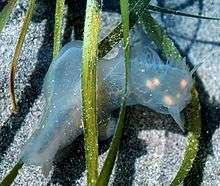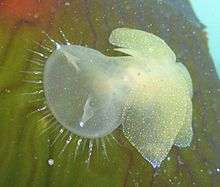Melibe leonina
| Hooded nudibranch | |
|---|---|
 | |
| Melibe leonina | |
| Scientific classification | |
| Kingdom: | Animalia |
| Phylum: | Mollusca |
| Class: | Gastropoda |
| (unranked): | clade Heterobranchia clade Euthyneura clade Nudipleura clade Nudibranchia clade Dexiarchia clade Cladobranchia clade Dendronotida |
| Superfamily: | Tritonioidea |
| Family: | Tethydidae |
| Genus: | Melibe |
| Species: | M. leonina |
| Binomial name | |
| Melibe leonina Gould, 1852 | |
| Synonyms | |
| |
Melibe leonina, common names the "hooded nudibranch", "lion's mane nudibranch", or "lion's mane sea slug" is a species of predatory sea slug, specifically a nudibranch, a marine gastropod mollusk in the family Tethydidae.
Distribution
This species occurs on the west coast of North America, from Alaska to Baja California.
Description

This nudibranch is up to 102 mm long, 25 mm wide, and 51 mm across the expanded oral hood.
The body of this nudibranch is translucent. It is usually colorless to pale yellow or green, with opaque brown hepatic diverticula. It has a large expandable oral hood, fringed with sensory tentacles, which it opens and throws forward in order to catch food. A single pair of rhinophores on the hood are rounded and earlike. 4-6 pairs of flat paddle shaped cerata run along its dorsum in two rows.
Melibe leonina exudes a sweet fruity aroma when it is removed from the water, or when numerous individuals are kept together in captivity. Because of their smell and the way they expand their oral hoods while attached to kelp and eelgrass, a group of Melibe is called a "bouquet".
Ecology
Habitat

Found on eelgrass and other seaweeds near low tide and below, and in kelp forest in deeper water.
Feeding habits
Melibe leonina is carnivorous and hunts for food, while attached to grasses, by extending its oral hood out and downward like a net. When the ventral surface of the hood contacts a small animal, the hood rapidly closes and the fringing tentacles overlap, holding in the prey then forcing the whole animal into the mouth. Prey include amphipods, copepods, mysids, other small crustaceans, small mollusks, small jellyfish and ctenophores, larvae of other invertebrates and in some cases small fish.
Life cycle
Like most other sea slugs, Melibe leonina is a hermaphrodite. They apparently live about one year, reciprocally fertilize one another, lay their eggs and die. Eggs are attached to kelp and eelgrass in long, wide yellow or cream-colored ribbons which form tight coils or wavy folds.
Predators
Predators may include fish, kelp dwelling crabs and sea stars, but when disturbed Melibe leonina has the ability to autotomize (shed) its cerata. This will hopefully lead the would-be attacker away as the discarded appendages float off, or at least cause a distraction long enough for the sea slug to make an escape.
When harassed or dislodged, Melibe leonina is capable of swimming. It uses rhythmic lateral-bending movements, and can sometime travel long distances across open water. The upside-down, side-to-side thrashing motion may look awkward, but it is a complex series of movements which has been studied extensively.
References
Further reading
- Gosliner T.M. (1987) Review of the nudibranch genus Melibe (Opisthobranchia: Dendronotacea) with descriptions of two new species. The Veliger 29(4): 400-414.
- Behrens, Dave. "Melibe leonina" The Slug Site. Sept. 1999. 15 May 2008 <http://slugsite.us/bow/nudwk188.htm>.
- Meinkoth, Norman A. National Audubon Society Field Guide to North American Seashore Creatures. New York: Alfred a Knopf, Inc., 1981. 531-532.
- Various. "The Sea Slug Forum - Melibe Leonina", The Sea Slug Forum. 15 May 2008 <http://www.seaslugforum.net/showall.cfm?base=melileon>.
- W.H. Watson III, K.D. Lawrence and J.M. Newcomb. 2001. Neuroethology of Melibe leonina swimming behavior. American Zoologist 41(4): 1026-1035. <http://icb.oxfordjournals.org/cgi/content/full/41/4/1026>.
- Watson, W.H. and J. Trimarchi. 1992. A quantitative description of Melibe feeding behavior and its modification by prey density. Marine Behaviour and Physiology 19: 183-194.
- Trimarchi, J. and W.H. Watson. 1992. The role of the Melibe buccal ganglia in feeding behavior. Marine Behaviour and Physiology 19: 195-209.
- Watson, W.H. III. and C.M. Chester. 1993. The influence of olfactory and tactile stimuli on the feeding behavior of Melibe leonina (Gould, 1852) (Opisthobranchia: Dendronotacea). The Veliger 36(4): 311-316.
- Newcomb, J.M. and W.H. Watson III. 2001. Identifiable nitrergic neurons in the central nervous system of the nudibranch Melibe leonina, localized with NADPH-diaphorase histochemistry and nitric oxide synthase immunoreactivity. J. Comp. Neurol. 437: 70-78.
- Newcomb, J.M. and W.H. Watson III. 2001. Modification of swimming in the gastropod Melibe leonine by nitric oxide. J. exp. Biol. 205: 397-403.
- K.A. Lawrence and W.H. Watson III. 2002. Swimming behavior of the nudibranch Melibe leonine. Biol. Bull. 203: 144-151.
- Watson, W.H. III, J.A. Newcomb and S. Thompson. 2002. Neural correlates of swimming behavior in Melibe leonina. Biol. Bull. 203: 152-160.
- Newcomb, J.M., K.D. Lawrence and W.H. Watson III. 2005. The influence of light on locomotion in the gastropod Melibe leonina . Marine and Freshwater Behav. & Physiol. 37: 253-269.
- Thompson, S. and W. H. Watson III. 2005. Central pattern generator for swimming in Melibe J. Exp. Biol. 208:1347-1361.
- Agersborg H. P. K. (1923). "The Morphology of the Nudibranchiate Mollusc Melibe (syn. Chioraera) leonina (Gould)". Quarterly journal of microscopical science 67: 507-592.
- Agersborg H. P. K. (1923). "A CRITIQUE ON PROFESSOR HAROLD HEATH'S CHIORAERA DALLI, WITH SPECIAL REFERENCE TO THE USE OF THE FOOT IN THE NUDIBRANCHIATE M0LLUSK, MELIBE LEONINA GOULD". The Nautilus 36(3): 86-96.